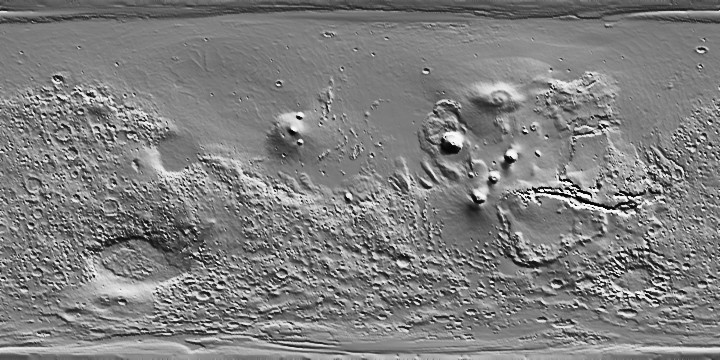
Mars is the first planet that Earth-bound astronomers were able to study in detail, since surface markings can be seen with even a modest-sized telescope.
Since 1877, there has been some discussion of Mars being inhabited by intelligent life forms. An Italian, Schiaparelli, published his drawings of Mars with surface markings that he called "canali" (channels). This got translated into canals, implying that someone built them. This motivated a long and detailed search for evidence of life on Mars.

Here is set of ground-based images of Mars from the Lowell Observatory in Flagstaff:

Image from http://www.goddardmultimedia.fsnet.co.uk/atpai/CanalsMars.htm
This image set was taken at a 3.6 meter telescope on Hawaii in 2001:

The Hubble Space Telescope has also been a fantastic resource for studying Mars. This set of images shows four views of Mars in 1997 (Mars Northern Summer):

Spacecraft exploration of Mars began in 1965, and the 22 images sent back to Earth by Mariner 4 put any thoughts of civilizations with extensive canals to rest. Instead, the images showed a barren planet with an abundance of impact craters:


The first lander missions (Viking 1 and 2) studied the surface of Mars in 1976:


Current/recent missions to Mars:
As with any high-risk space program, there have been some failures. The most embarassing failed Mars mission was the Mars Climate Orbiter, which was supposed to arrive in 1999. It is believed that the spacecraft was lost due to a confusion on the units (English vs. metric) when various engineering teams did the calculations for the spacecraft maneuvers to put it into orbit. The full story can be found here.
Mars' diameter is roughly half that of the Earth, so it is substantially smaller than Earth and Venus. It's average density of 3.9 g/cm3 is between that of the Moon (3.3) and the Earth (5.5). What does this suggest about its interior structure?
Roughly half of Mars' surface is heavily cratered, like the lunar highlands. The cratered areas are located primarily in the southern hemisphere. The northern hemisphere contains younger, lightly cratered volcanic plains (like the lunar maria!). There is a large uplifted continent located across the equator, and this area contains a lot of interesting geologic features.


Mars Orbiter Laser Altimeter (MOLA) map of the surface topography, along with previous landing sites. Image from http://mola.gsfc.nasa.gov/index.html.

Greyscale MOLA surface relief map. Image from http://mola.gsfc.nasa.gov/index.html.
MOLA surface relief map of Mars' North Pole region (72 degrees N and higher). Image from http://mola.gsfc.nasa.gov/index.html.
Most of the volcanism on Mars took place in the Tharsis region (the large, uplifted continent). Mars contains the largest volcano in the solar system: Olympus Mons. It is much larger than the largest volcano on Earth, both in height and diameter. Virtually no impact craters are found along the slopes of Olympus Mons, suggesting that the lava flows are VERY young (less than 100 million years old -- young compared to the age of the solar system, which is 4.5 billion years old).

Taken from the Viking Orbiter

Image courtesy of Malin Space Science Systems/NASA, from Mars Global Surveyor in 1998